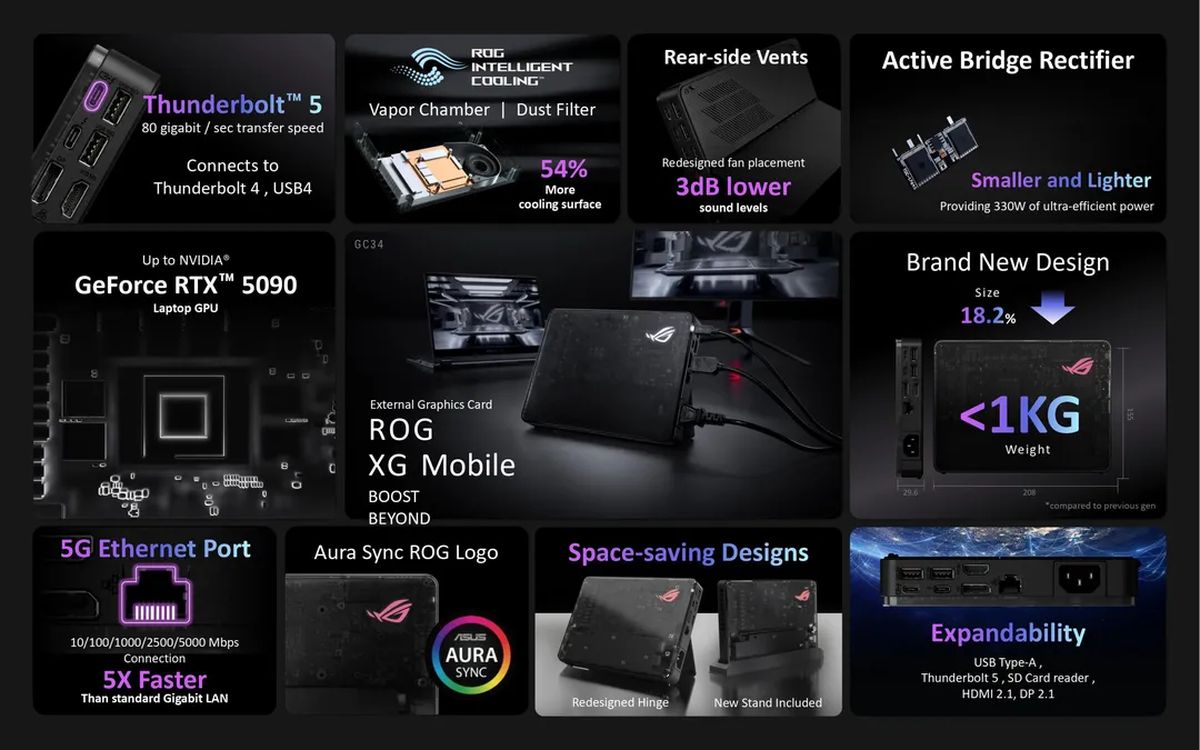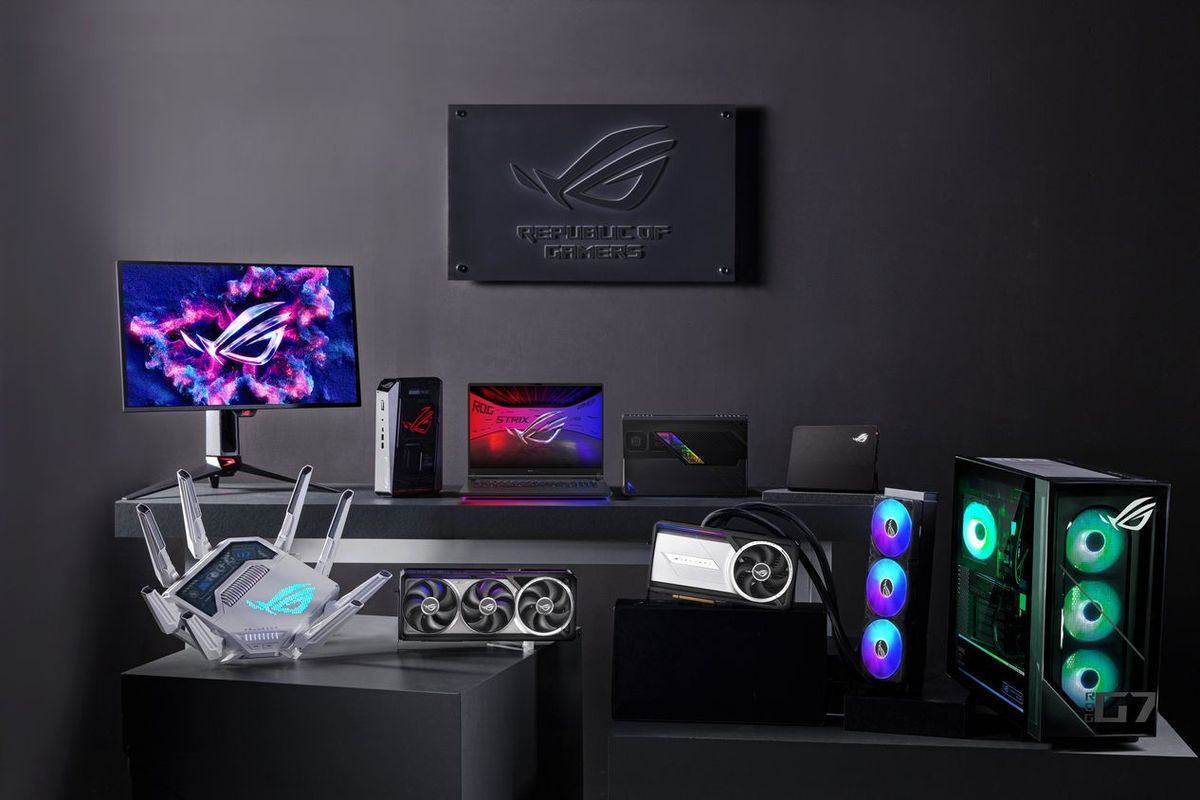Asus has introduced the world’s first Thunderbolt 5 eGPU, the 2025 Asus XG Mobile, which promises powerful graphics and extensive connectivity when connected to compatible laptops and handhelds.
Asus XG Mobile features and specifications
The Asus XG Mobile is a smoky black translucent box that serves as a powerful portable docking station rather than a traditional gaming PC. When connected, it adds the power of Nvidia’s GeForce RTX 5090 mobile chip, up to 140 watts of power, supports dual monitors, and includes a USB and SD card reader hub as well as 5Gbps ethernet, all connected via a single Thunderbolt 5 cable. This dock operates on an 80 gigabit per second bidirectional link, allowing for more functionalities than previously seen with a single cable.
Asus claims the XG Mobile is the first standards-based portable eGPU featuring an Nvidia graphics chip. Previous models, like the last-gen XG Mobile, required a proprietary connection only available on select Asus devices, limiting its accessibility compared to this new standard. Additionally, while it may not outpower larger docks that house desktop graphics cards, the Thunderbolt 5 link provides up to 64Gbps of bandwidth for the Nvidia graphics.
CES 2025: Dell will call its laptops “Dell” from now on
Weighing under 2.2 pounds, the XG Mobile includes a 350W power supply integrated into the unit, requiring no external brick. The new model is said to be 25 percent lighter and 18 percent smaller than its predecessor. It offers HDMI 2.1 and DisplayPort 2.1 for video output, along with two 10Gbps USB-A ports.
The highest-tier version of the XG Mobile, featuring the RTX 5090 mobile chip, is priced at $2,199.99, while a lower-end model with the RTX 5070 Ti will retail for $1,199.99. The device is designed to work with any Thunderbolt 4 or USB4 laptop or handheld, but to fully utilize the GPU bandwidth, a Thunderbolt 5 connection is recommended.

Updated Asus Zephyrus models
The Asus ROG Zephyrus G14 is receiving an upgrade to include an RTX 5080, maintaining a slim profile at 0.63 inches thick and weighing 3.46 pounds. This year’s model has increased in size by just 2mm compared to last year’s version, which topped out with an RTX 4070. It will feature an AMD Ryzen AI 9 HX 370 processor, up to 2TB of PCIe 4.0 storage, and 32GB of LPDDR5X-7500 memory, alongside the same 2,880 x 1,800 ROG Nebula OLED display with a 240Hz refresh rate. The laptop also supports Wi-Fi 7 and Bluetooth 5.4. The current design remains unchanged, with customizable Slash Lighting included but retains limitations such as soldered memory and potential overheating issues.
CES 2025: Nvidia RTX 5090 brings 2X the power of 4090
The 16-inch Zephyrus G16 will similarly be upgraded to support the RTX 5090, featuring up to 130 watts of power, alongside a potential configuration of up to 64GB of RAM with an Intel Core Ultra 9 285H. The external design remains unchanged except for a minor adjustment of one USB-C port to the other side.
Asus has not yet disclosed release dates or pricing for the upgraded Zephyrus laptops, but previous models experienced price increases due to premium materials, leading to anticipation regarding the cost of these upcoming devices.

Asus ROG Strix Scar 18 upgrade details
The 2025 Asus ROG Strix Scar 18 has been redesigned to prioritize user upgradeability. It features a new design with RGB down-lighting and a Mini-LED Nebula HDR display, along with a new Intel HX Series mobile CPU and Nvidia RTX 50-series GPU. The laptop incorporates a tool-less upgrade mechanism, featuring a single sliding latch that reveals access to NVMe slots and SO-DIMM memory packages for easy swapping.
Asus has also introduced several new models in the RTX 5000 series during CES 2025, releasing six systems equipped with the latest Nvidia Blackwell GPUs. The ROG Strix Scar 16 and 18 can be configured with up to an RTX 5090 and Intel Core Ultra 9 285HX CPUs, supporting mini LED panels and offering 100 percent DCI-P3 color accuracy. Cooling systems within these models utilize Conductonaut Extreme liquid metal on the CPU and GPU, designed to operate with a noise level of 45 dB while maintaining peak performance.
The Strix G16 and G18 cater to a mainstream audience with slightly lower specs, supporting up to an RTX 5080 on Intel models, while AMD configurations maximum out at an RTX 5070 Ti. All variants feature ROG Nebula screens with the same mini LED technology for enhanced visuals and support for dual M.2 slots, facilitating user upgrades.
Featured image credit: Asus





